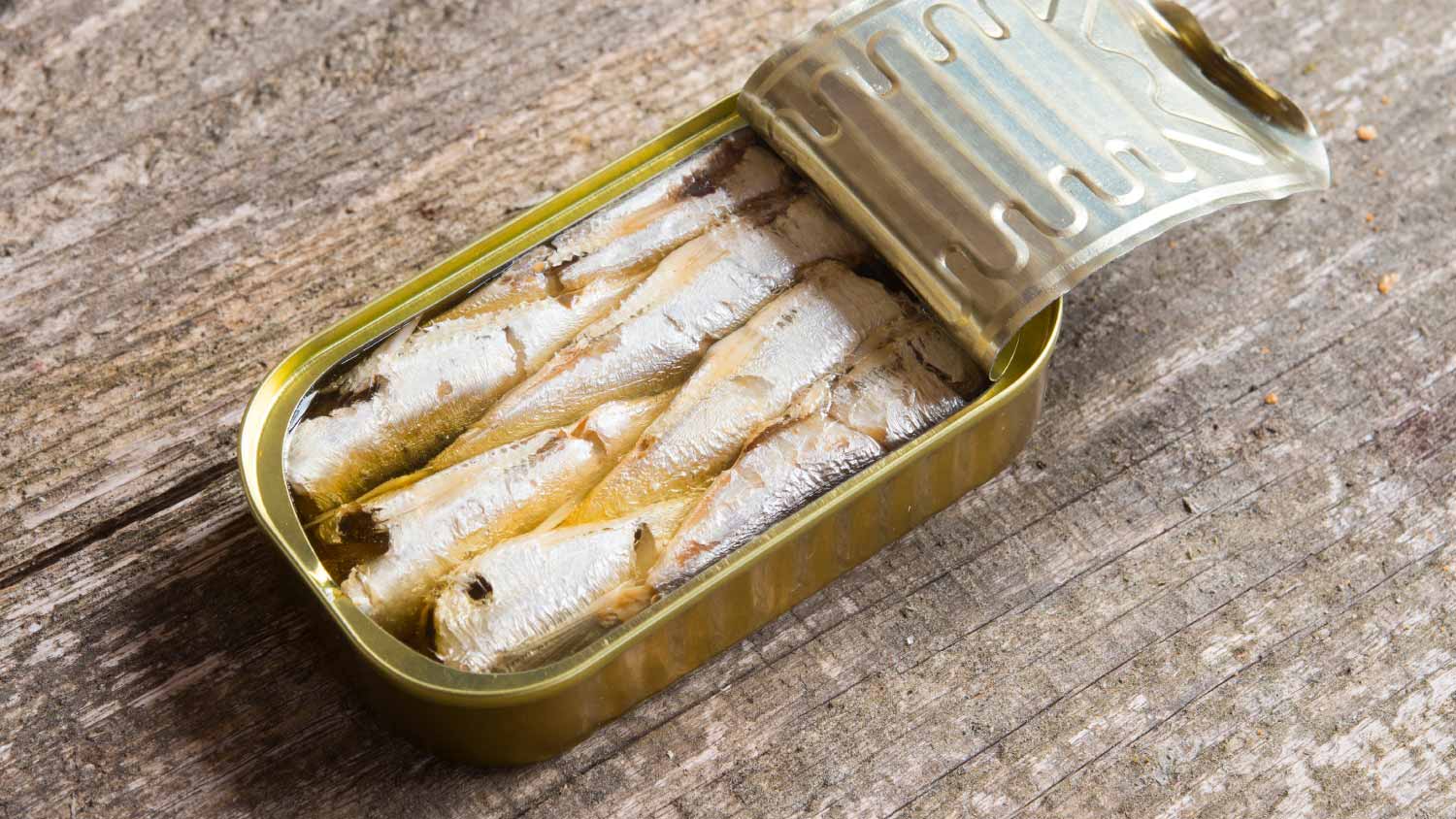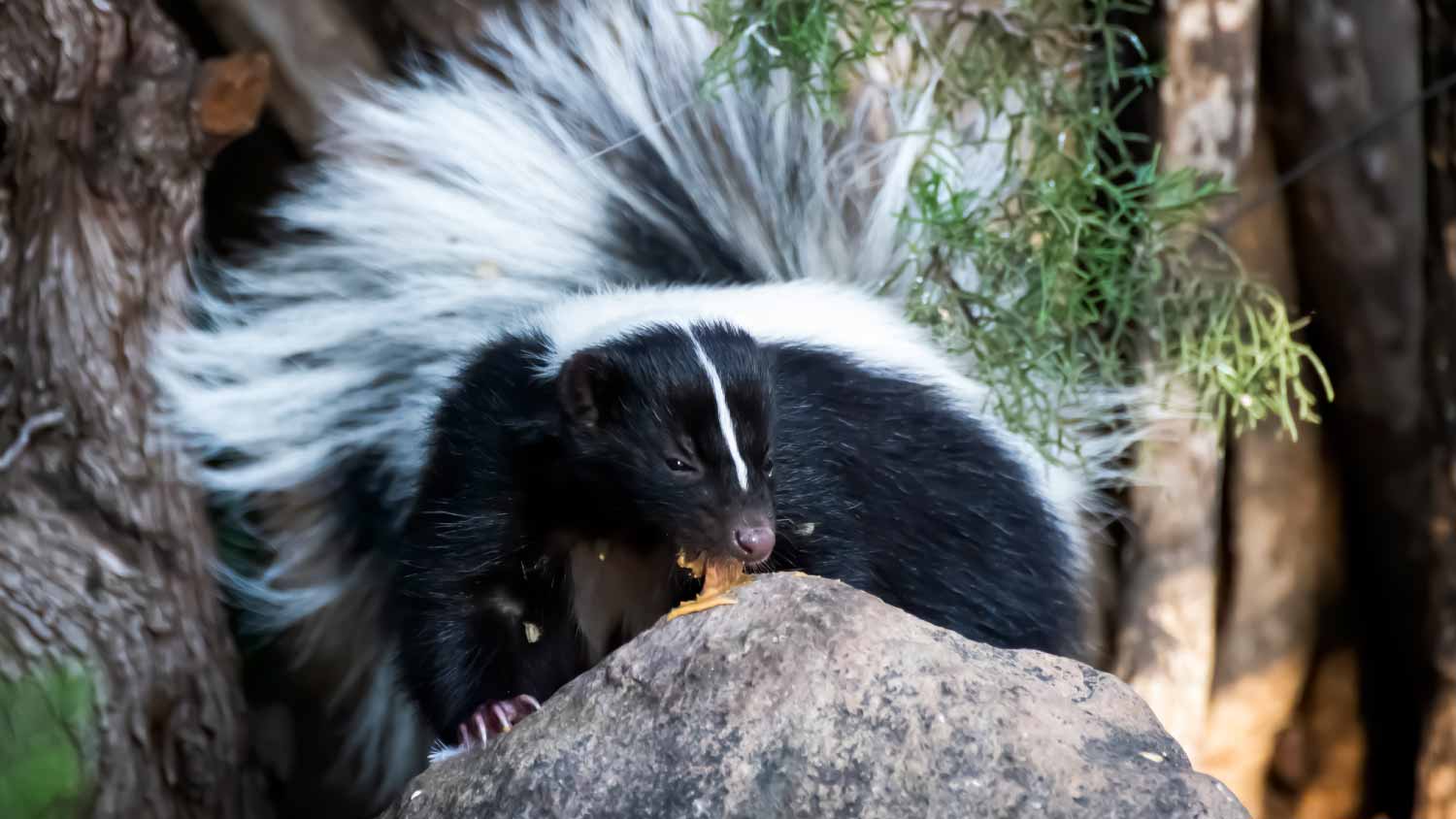
Raccoons on your property can cause a lot of damage to your home and yard. This guide breaks down raccoon removal costs so you can budget accordingly.
Say goodbye to stinky surprises by opting for safe skunk removal


Skunks are harmless—as long as you don’t corner them—and beneficial for controlling pests. However, they can tear up lawns looking for food, and their smelly spray is a nuisance. Relocation is one solution, which makes knowing the best bait for skunks to use for humane trapping essential. Skunks like fresh, aromatic food due to their strong sense of smell. Just remember to set traps at night since skunks are nocturnal.
Trapped animals can be dangerous, no matter their size. Do not attempt to handle them—call in a pro for safe removal instead.

Effectiveness: Very high
While a can of sardines is more expensive than other types of bait, like peanut butter or marshmallows, its fishy odor is highly effective at luring skunks from a considerable distance.
To use, open a can and place it at the back of the trap, ensuring the strong smell permeates the area. Canned salmon or tuna are excellent alternatives if your local market doesn't carry sardines.
Once trapped, call a local skunk control specialist to remove and relocate the animal.
Note: As with most types of bait, other animals, including raccoons and bears, are attracted to canned fish.
| Pros | Cons |
|---|---|
| Pungent smell | Attracts other animals |
| Effective from distance | Oily and messy |
| Easy to use | Spoils in heat |
| High success rate | Expensive |
Best for: Homeowners needing potent skunk bait that can attract from a distance
Effectiveness: Very high
Wet cat food is highly effective as skunk bait due to its robust scent and moist texture. Fishy, high-aromatic varieties are particularly good at attracting skunks from a distance, encouraging them to enter the trap.
Additionally, small cat food containers are more cost-effective than sardines, making them a better choice for setting up multiple traps. However, wet cat food has a shorter shelf life than other types of canned foods, including sardines.
| Pros | Cons |
|---|---|
| Strong, meaty scent | Attracts other animals |
| Easy to use | Can spoil in the heat |
| Cheaper than sardines | May attract insects |
| Highly effective | Short shelf life |
Best for: Homeowners looking for an effective and affordable bait

Effectiveness: High
Many skunks find peanut butter irresistible because of its nutty aroma. Spread a generous amount of peanut butter on a piece of bread, a small cracker, or a shallow dish.
Place the bait at the back of the trap to ensure the skunk fully enters it before it triggers. Peanut butter's sticky nature ensures that skunks work to get the bait, increasing the chances of triggering the trap.
| Pros | Cons |
|---|---|
| Strong aroma | Attracts other animals |
| Easy to use | Messy application |
| Readily available | Heat spoilage |
| Inexpensive | Limited scent range |
Best for: Homeowners looking for an affordable solution for multiple traps
Effectiveness: Moderate
Protein-rich foods like uncooked chicken are very appealing to skunks. Raw chicken is also safer for animal consumption than cooked because its bones are less likely to splinter.
However, fresh chicken can be less effective than other types of skunk bait. Chicken spoils quickly, especially in warm weather, losing its appeal and scent, while sardines, cat food, and even peanut butter maintain their aroma longer.
Additionally, raw chicken attracts other predators and opportunistic hunters, such as dogs, bears, raccoons, and foxes, which can interfere with trapping efforts. Lastly, handling uncooked chicken carries a risk of salmonella.
| Pros | Cons |
|---|---|
| Highly attractive | Spoils quickly |
| Safe bones | Attracts predators |
| Protein-rich | Loses scent quickly |
| Readily available | Salmonella risk |
Best for: Homes located in areas without dangerous predators like bears

Effectiveness: Moderate
Skunks have a sweet tooth, making sugary foods like marshmallows wildly appealing. These sweet treats are also easy for humans to handle when setting traps and are a cost-effective option for baiting numerous traps on a budget.
However, marshmallows lack the robust and long-lasting aroma of sardines and cat food, which can attract skunks from greater distances. They also dissolve quickly in water, such as in rainy conditions. Moreover, marshmallows are less nutritionally appealing than protein-rich baits like raw chicken and peanut butter.
| Pros | Cons |
|---|---|
| Sweet treat | Attracts bugs |
| Easy to handle | Unnatural food source |
| Inexpensive | Limited scent range |
| Readily available | Dissolves in water |
Best for: Dry areas with limited food sources or raccoons
To safely trap a skunk, plan carefully and consider your safety and the skunk's welfare. Check local wildlife regulations for compliance. Use a humane skunk trap with a protective cover, which costs $60 to $120. These traps allow the animal to breathe while shielding you from spraying. If relocation is allowed under local regulations, take the skunk to a suitable habitat at least 10 miles from residential areas.
Professional skunk removal costs an average of $450. While DIY trapping and relocation can save money, it’s not always safe, feasible, or legal to handle animals yourself.
Homeowners should contact their local wildlife control service before trapping a skunk or other animal. These experts ensure humane and effective removal, minimizing the risk of injury or disease. They also can address potential entry points in your yard to prevent future infestations. Additionally, professionals know local wildlife regulations, ensuring your situation is dealt with legally and humanely.
Our office has a new lease on life, thanks to Custom Paint Jobs LLC. Outstanding work!
Window Depot did an amazing job on my deck. I wasnt sure what I wanted to do, but their composite decking was affordable and will last a long time. I am excited to have family over, and I am no longer embarrassed by my backyard. Jeff and the ground crew were polite, respectful, and caring for...
Jeff was a consummate professional. Responsive, courteous, and focused on meeting our needs. I had a small project of installing and replacing two ceiling light fixtures. He responded to my Home Advisory inquiry within 24 hours and in a span of two weeks our light fixtures were installed. ...
We used Unique Hardwood Floor LLC three years ago to work on the floors of a 70 year old home that needed a great deal of work. Some floors needed repairs, some were replaced and others just needed to be refinished. It was a complicated job as they needed to blend the old and the new to...
Lyle did a great job removing asbestos shingles from our front porch roof. They worked together with our roofer to make sure that the new roof was able to be installed on the same day that Lyle removed the asbestos shingles.
Involved an extensive bathroom remodel, including removing tub & installing walk in shower, new drywall, custome tile work to ceiling, plumbing, etc. Overall, job was done on time and on budget. Nick & his team were very professional and had high attention to detail. Quality was great. Highly...
Extremely well. Ohio Tree Care is my go to company for all tree care and snow removal services. they are professional, knowledgeable and affordable. I manage five camps in 33 counties and Ohio Tree Care has serviced every one of our properties. Highly recommend.
From average costs to expert advice, get all the answers you need to get your job done.

Raccoons on your property can cause a lot of damage to your home and yard. This guide breaks down raccoon removal costs so you can budget accordingly.

When budgeting for possum removal costs, consider number of animals, location, method of removal, and whether you do it yourself or hire a professional.

When calculating wildlife removal costs, you’ll need to consider the type, size, and amount of animals. Our guide will show you the wildlife removal cost.

We’ve outlined how to trap armadillos to increase your chances of success with this tricky task and help you know when to hire a pro.
Not sure how to get rid of animals in your attic? Get comprehensive tips to identify what’s up there and how to send them packing from your home.

Wondering how to get rid of squirrels in your yard without going nuts? Here’s what to know about keeping squirrels away from your walls, attic, and yard.